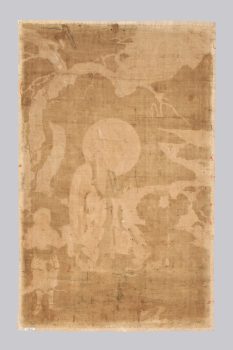Tibet
16th century


Tibet
16th century


Abheda is one of the sixteen arhats, the original disciples of the Buddha in India. His identifying attribute is a stupa, which he holds in both hands. Typically the arhats are depicted as a group, so this painting is likely part of a larger set of up to twenty-three paintings. Interestingly, this arhat is dressed in Chinese monastic robes. The arhat genre was imported from China, and this painting exemplifies the deftness with which Tibetan artists were able to emulate Chinese painting techniques and the depiction of Chinese material culture. Especially impressive is the use of ink, from the sensitive delineation of the arhat’s face and sunken chest to the subtle, textile-like pattern in the texture of the tree bark behind him. Gnarled pine trees, like the one that frames Abheda here, are associated with longevity in Chinese painting traditions, and resonates with the wizened arhat’s appearance. The grouping of pine tree, bamboo, and plum is a popular motif in Chinese painting known as the “three friends of winter” because of their ability to thrive even in the harshness of winters and together embody steadfastness, perseverance, and resilience. Chinese objects depicted include a bound book, bronze incense brazier and hu vase on the rock to Abheda’s right, while the stupa, delicately picked out in gold, is Tibetan in form. The winding stream in the landscape is a visual device used to suggest receding space.
A vehicle for the preservation and transmission of knowledge. The Buddha’s teachings were originally passed down through oral transmission and storytelling, and stories of the Buddha’s past lives are considered an important source of inspiration and guidance.
In Buddhism merit is accumulated through engaging in positive actions that lead to positive results, such as better rebirths. Buddhists gain merit by making offerings, donating to those in need, reciting mantras, and other good deeds.
The central goal of Buddhism is the liberation of all beings from suffering and the cycle of life, death, and rebirth, known as samsara, through applying the teachings of the Buddha.
Himalayan art includes portraits of legendary and historical humans, including accomplished religious teachers (lamas), the Buddha’s original disciples (arhats), and spiritually accomplished tantric masters (mahasiddhas).
Today, Tibetans primarily inhabit the Tibetan Plateau, situated between the Himalayan mountain range and the Indian subcontinent to the west, Chinese cultural regions to the east, and Mongolian cultural regions to the northeast. During the 7th to 9th century, Tibetan rulers expanded their empire across Central Asia, and established Buddhism as the state religion.
Get the latest news and stories from the Rubin, plus occasional information on how to support our work.